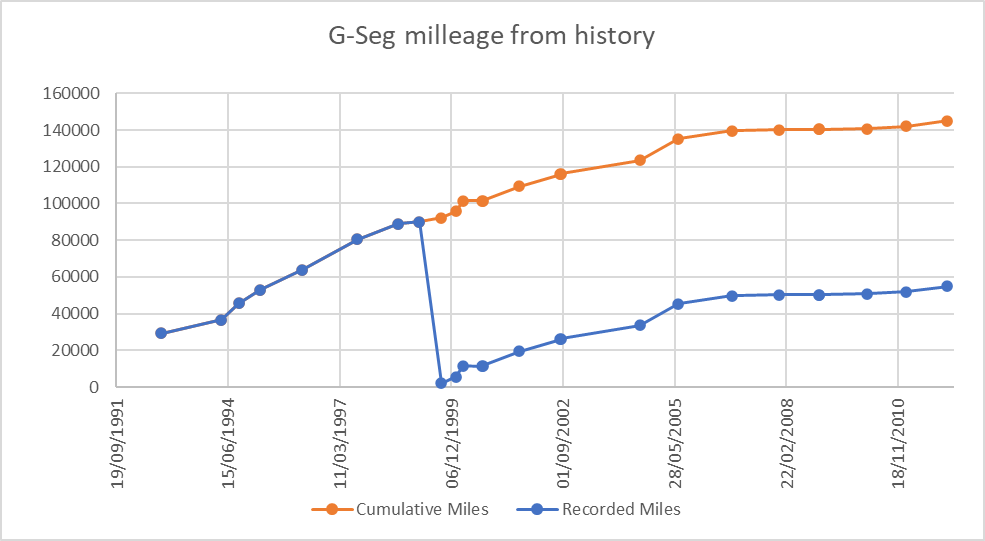My current Citroën BX Project, usually referred to as ‘XPO’ due to its registration, came as two halves. The rolling shell had its original engine removed in 2008, and came to me with quite an extensive history. The other half of this project is the engine, which came from a donor vehicle which I refer to as ‘G-SEG’. Notice a trend? Having purchased the project from quite the petrol head, the project came with a lot of history. Let’s look at what came with the engine, and if it gives clues to the life the engine has lived.
The origins of the spare engine
Before the project arrived, I knew just two things about the engine. It came from a car known as G-SEG and was removed as a running engine. I also had this picture.

G-SEG was well-known within the BX community and in its heyday was one of the best looking Citroen BX 16Valves on the road. The immaculately presented bodywork and tidy interior were hard to fault. But the shiny surface hid quite the secret, the underside of the car was less than immaculate. Years of underside neglect lead to more rot than could be readily restored and the car was scrapped. The loss of G-SEG was not in vain though, the parts live on in many other cars.
An Engine With Plenty of History
When the car arrived back in February, it came with two things I didn’t expect. A pack of beers and a folder full of history, neatly divided into history for the shell and the engine. Quite a lot of history in fact dating all the way back to when the car was new. It certainly seemed like an engine that had seen a lot of care in its early days.

The early years of G-SEGs life saw it receive regular servicing at main dealers including both Citroen Northants and Honda in Leicester. The car, and engine, seem to of been in regular use for its first ten years, averaging a constant 10,000 miles a year. It has also seen not one, but two cambelt changes.
The early history also suggests perhaps an attentive owner as there are entries that suggest some running issues. ‘Reset of the fuel mixture’, ‘ISCV Cleaned’, ‘CO Reset’ all within the first 70,000 miles. In fact, this is a trend that continues throughout the engines 22 years with G-SEG. Typically the emissions were being tweaked at MOT time. For me, this is a bit of a red flag. A garage once ‘adjusted’ my emissions on the Citroen BX 16Valve engine, and I had to buy a new AFM as a result.
A glitch in the mileage history?
When looking through the history of a car, I like to get it all in chronological order. The odd thing about G-SEGs engine history was that in chronological order, the odometer readings jumped around, a lot. I’d always understood G-SEG to have relatively low mileage for a BX 16Valve so seeing no history over 100,000 miles didn’t come as a big surprise. Eventually, the reality came out of the data.

Sometime in late 1999, G-SEG received a new odometer and the mileage reset to zero. There’s nothing in the history as to why this happened, and it is a little curious. The BX odometer does jam, and the speedo is notorious for wobbling, but both can be fixed without replacement. Perhaps a replacement part was easier to fit than spending a few hours fixing the existing odometer?
Either way, my expectation that this was around a 100k mile car. The reality was it was the engine was over 140k miles when it last ran. I guess this goes some way to explaining why it was down on power when rolling roaded in 2013. This was just before it was taken off the road, and showed just 140bhp of an expected 160bhp when new.
What has the engine seen in 140k miles?
While stripping down the engine, I found a lot of evidence of poor engine maintenance and assembly practices. From a plethora of spare nuts, bolts, and 10mm sockets to a serious overuse of liquid sealant. Despite the cambelt being changed just 5000miles before the car was taken off the road, the job was clearly rushed with little care being taken to put the engine back together correctly.
Perhaps unsurprisingly, there is no mention in the history of snapped bolts, drilling and tapping, removal of water manifolds. There is also no mention of valves being bent as discovered when overhauling the cylinder head. There’s also no mention of the crankshaft rattling around and becoming oval. The missing 20 brake horsepower was probably hard to notice with G-SEG seeing little use in its final years. Just 10,000 miles in 10 years is even less than I’ve managed in Jazz.
And what does all this history mean?
The history gives a great record of the aging of the engine. It really shows the early care the engine received, and the way it gained miles over time. Paperwork from different garages gives a great insight to how the car has travelled around the country from one owner to another. These are the sorts of details which will help to give XPO some soul once its back on the road.
What it doesn’t give us an idea of the quality of the work that was carried out. The bent valves aren’t recorded, because they probably weren’t noticed. The warn-out crankshaft is hard to measure without taking the bottom out of a running engine. Who on earth would do that?
The history is great to have, but in this case, it doesn’t give the full picture, and I’m glad I’ve pulled the whole engine apart!
M
NEXT – A Crank for the D6C Engine
PREV – Building the Cylinder Head
Back to Citroen articles
Back to Automotive articles
